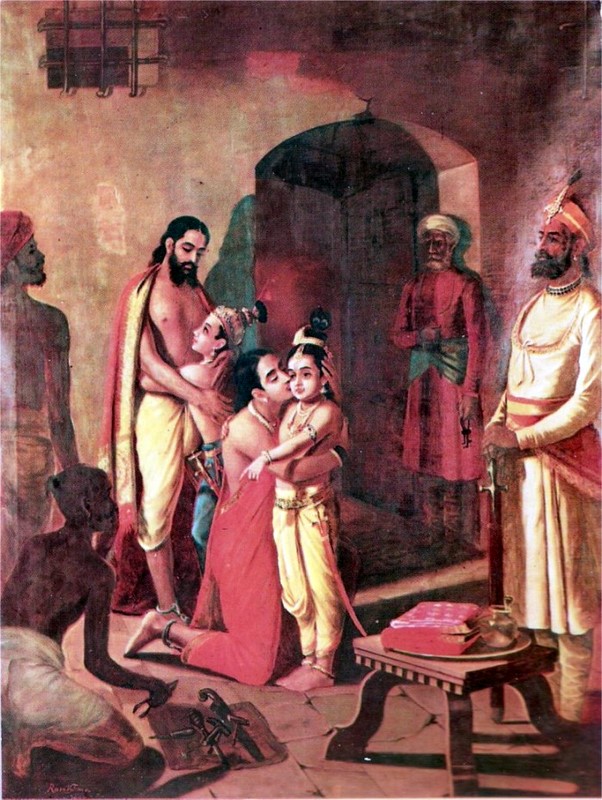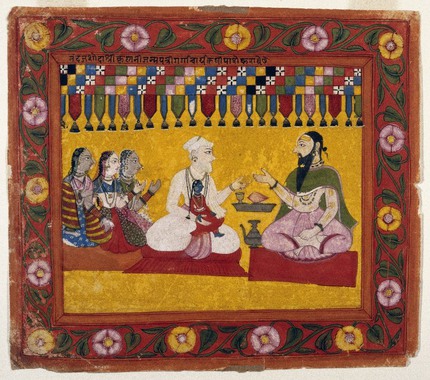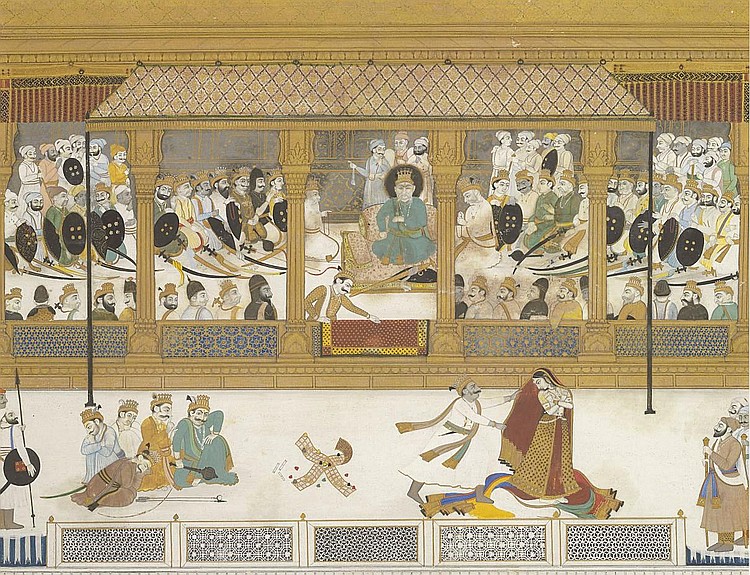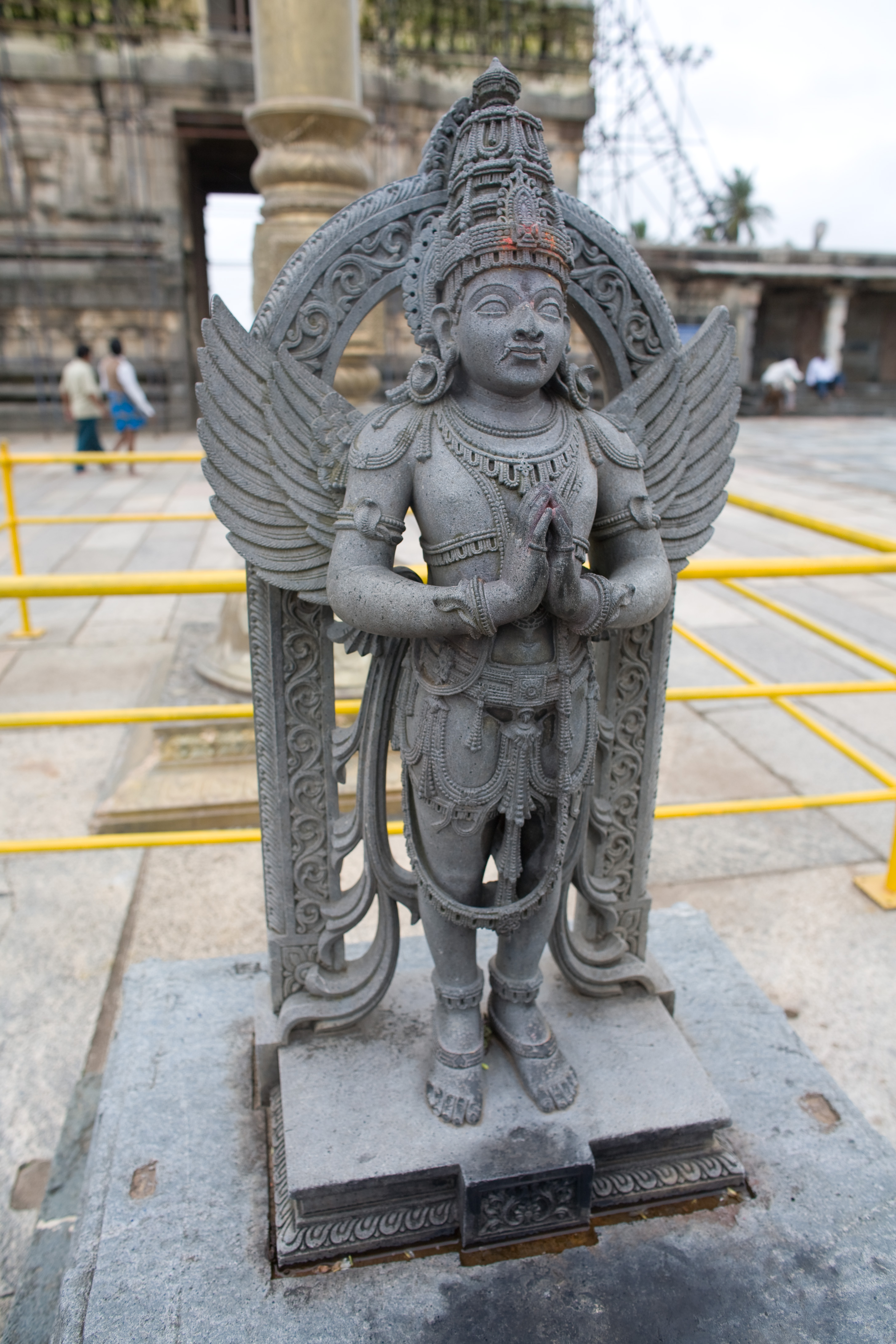|
Rohini (wife Of Vasudeva)
In Hindu mythology, Rohini (, ) is the first consort of Vasudeva , and the mother of the Hindu deities Balarama and Subhadra. She plays a prominent role in the upbringing of Krishna. Legend Rohini is described as the daughter of the king Bahlika, making her a cousin of Bheeshma. She is married to Vasudeva, a descendant of Yadu, a Chandravamsha king. Her sister, Pauravi, was also married to Vasudeva. Vasudeva also married Devaki, a princess of Mathura. The couple is imprisoned by Devaki's brother Kans, soon after their marriage. as a divine prophecy predicted Kans's death by Devaki's eighth son. While Vasudeva is imprisoned, Rohini lives at the house of her husband's cousin Nanda, in Vraja. While all previous sons of Devaki are slain, the seventh embryo is transferred to Rohini's womb. Rohini gives birth to Balarama. Krishna, the eighth child of Devaki, was exchanged with the daughter of Nanda and Yashoda in secrecy. Yashoda (foster-mother of Krishna) and Rohini play ... [...More Info...] [...Related Items...] OR: [Wikipedia] [Google] [Baidu] |
Vasudeva
Vasudeva (; Sanskrit: वसुदेव ), also called Anakadundubhi (''anakas'' and ''dundubhis'' both refer to ''drums'', after the musicians who played these instruments at the time of his birth), is the father of the Hindu deities Krishna ( Vāsudeva, i.e. "son of Vasudeva"), Balarama, and Subhadra. He was a king of the Vrishnis. His sister Kunti was married to Pandu. The patronymic ' (with a pronounced ''ā'') is a popular name of Krishna, the son of Vasudeva and Devaki. "Vāsudeva" is a vṛddhi, a derivative of the short form "Vasudeva", a linguistic pragmatic in Sanskrit signifying "of, belonging to, descended from". "Vasudeva" as an object of worship in Hinduism usually refers to the son (Krishna), rather than his father Vasudeva. Family Vasudeva was born to the Yadava king Shurasena in the Surasena kingdom of Khandalwansha. Vasudeva had many brothers such as Devashrava and Devabhaga, and 5 sisters Srutakirti, Kunti, Rajadhidevi, Srutadeva (Mother of the ... [...More Info...] [...Related Items...] OR: [Wikipedia] [Google] [Baidu] |
Nanda Baba
Nanda or Nandagopa (, ) is a cow-herd chief, and the foster-father of Krishna, featured in the Harivamsha and the Puranas. Nanda is the son of Parjanya, a ruler of the Vraja region, who is a son of Devamidha. He is the chief of Gokulam, which was one of the mandals of the yadava tribe. He is sometimes referred to as a king but was a cow-herder in real. Nanda was a brother of Vasudeva. Vasudeva takes his newborn son, Krishna, to Nanda on the night of the child's birth, so that Nanda could raise him and to protect new born Krishna from his maternal uncle Kamsa. The chief, who is married to Yashoda, brings up both Krishna, and his brother, Balarama. Krishna derives his epithet ''Nandanandana'' (son of Nanda) from him. Legend Nanda was the foster-father of Krishna. He also helped to raise Balarama. Nanda, identified as King Nanda in many scriptures was a kinsman and a great friend of Vasudeva. The fact that King Nanda and King Vasudeva were brothers is confirmed both by the Bhagav ... [...More Info...] [...Related Items...] OR: [Wikipedia] [Google] [Baidu] |
Characters In The Mahabharata
The '' Mahabharata'' is one of the two major Sanskrit epics of ancient India composed by Veda Vyasa. At its heart lies the epic struggle between the Pandavas and the Kauravas. The central characters include the five Pandava brothers— Yudhishthira, Bhima, Arjuna, Nakula, and Sahadeva—along with their wife Draupadi. On the opposing side, the hundred Kaurava brothers are led by the elder brother, Duryodhana. However, the ''Mahabharata'' is richly populated with other notable figures including Krishna, Bhishma, Drona, Karna, Kunti, Dushasana, Kripa, Dhritrashtra, Gandhari, Shakuni, Ashwatthama, Balarama, Subhadra, Vyasa, Abhimanyu, Pandu, Satyavati and Amba. The ''Mahabharata'' manuscripts exist in numerous versions, wherein the specifics and details of major characters and episodes vary, often significantly. Except for the sections containing the ''Bhagavad Gita'' which is remarkably consistent between the numerous manuscripts, the rest of the epic exists in ... [...More Info...] [...Related Items...] OR: [Wikipedia] [Google] [Baidu] |
Auspicious Dreams In Jainism
Auspicious dreams are often described in texts of Jainism which forecast the virtue of children. Their number varies according to different traditions and they described frequently as fourteen or sixteen dreams. They are seen by mothers of the prominent figures in Jainism including Tirthankaras, on the conception of their soul in the womb. They are interpreted as describing virtues and kingship of a future child. They are also found in various artistic media as an ornamentation. Dreams Their number and description differ according to major traditions of Jainism. According to Digambara tradition, there are 16 dreams while according to Śvetāmbara tradition, there are 14 dreams. Most of them are same. They are described in detail as dreams of queen Trishala, mother of Mahavira, in some Jain texts. These dreams features animals, objects and a goddess associated with positive virtues and kingship. They are generally considered positive symbols in Indian culture so they frequentl ... [...More Info...] [...Related Items...] OR: [Wikipedia] [Google] [Baidu] |
Swayamvara
''Svayaṃvara'' ( ) is a matrimonial tradition in ancient Indian society where a bride, usually from '' Kṣatriya'' (warrior) caste, selects her husband from a group of assembled suitors either by her own choice or a public contest between her suitors. This practice is mainly featured in the two major Sanskrit epics, the '' Mahābhārata'' and the '' Rāmāyaṇa'', though its prevalence and portrayal vary significantly between them. Origins of ''Svayaṃvara'' can be traced back to the Vedic period and few scholars suggest that it emerged from the ''Gāndharva'' marriage tradition, diverging from more ritualistic and arranged forms of marriage, and developed as a narrative device within the epics to highlight the heroism and valor of protagonists, aligning with the ''Kṣatriya'' ethos of competition and martial prowess. Despite being closely associated with the epics, ''Svayaṃvara'' is not listed as a form of marriage in the ''Dharmaśāstra'', a collection of Sanskrit te ... [...More Info...] [...Related Items...] OR: [Wikipedia] [Google] [Baidu] |
Kosala
Kosala, sometimes referred to as Uttara Kosala () was one of the Mahajanapadas of ancient India. It emerged as a small state during the Late Vedic period and became (along with Magadha) one of the earliest states to transition from a lineage-based society to a monarchy. By the 6th century BCE, it had consolidated into one of the four great powers of ancient northern India, along with Magadha, Vatsa, and Avanti. Kosala belonged to the Northern Black Polished Ware culture (c. 700–300 BCE) and was culturally distinct from the Painted Grey Ware culture of the neighboring Kuru- Panchala region, following independent development toward urbanisation and the use of iron. The presence of the lineage of Ikshvaku—described as a raja in the Ṛgveda and an ancient hero in the Atharvaveda—to which Rama, Mahavira, and the Buddha are all thought to have belonged—characterized the Kosalan realm. One of India's two great epics, Ramayana is set in the "Kosala- Videha" realm i ... [...More Info...] [...Related Items...] OR: [Wikipedia] [Google] [Baidu] |
Shesha
Shesha (), also known by his epithets Sheshanaga () and Adishesha (), is a serpentine demigod ( naga) and king of the serpents ( Nagaraja), as well as a primordial being of creation in Hinduism. In the Puranas, Shesha is said to hold all the planets of the universe on his hoods and to constantly sing the glories of Vishnu from all his mouths. He is sometimes referred to as Ananta Shesha. The Narayana form of Vishnu is often depicted as resting on Shesha, accompanied by his consort Lakshmi. Shesha is considered as one of the two mounts of Vishnu alongside Garuda. He is said to have descended upon Earth in the following human forms or incarnations: Lakshmana, brother of Vishnu's incarnation Rama during the Treta Yuga, and according to some traditions, as Balarama, brother of Vishnu's incarnation Krishna during the Dvapara Yuga. According to the Mahabharata (Adi Parva), his father was Kashyapa and his mother Kadru, though in other accounts, he is usually a primordial being cre ... [...More Info...] [...Related Items...] OR: [Wikipedia] [Google] [Baidu] |
Nāga
In various Asian religious traditions, the Nāgas () are a divine, or semi-divine, race of half-human, half-serpent beings that reside in the netherworld (Patala), and can occasionally take human or part-human form, or are so depicted in art. Furthermore, nāgas are also known as Dragon, dragons and Water spirit, water spirits. A female nāga is called a Nagin, or a Naiṇī Devī, Nagini. According to legend, they are the children of the sage Kashyapa and Kadru. Rituals devoted to these supernatural beings have been taking place throughout South Asia for at least 2,000 years. They are principally depicted in three forms: as entirely human with snakes on the heads and necks, as common serpents, or as half-human, half-snake beings in Hinduism and Buddhism. ''Nagaraja'' is the title given to the king of the nāgas. Narratives of these beings hold cultural significance in the mythological traditions of many South Asian and Southeast Asian cultures, and within Hinduism and Buddhism ... [...More Info...] [...Related Items...] OR: [Wikipedia] [Google] [Baidu] |
Kadru
Kadru (, ) is usually regarded as the daughter of Daksha and the consort of the sage Kashyapa in Hindu scriptures. Kashyapa is the son of Marichi, who is a manasputra, manasaputra, a mind-born son of Brahma. Kadru is best known as the mother of the nāgas, nagas, the race of serpents. Legends of Kadru detail her relationship with her elder sister Vinata, who was also one of Kashyapa's many wives. In one story, Kadru and Vinata vie to bear the children of Kashyapa who are more powerful than the other. While Kadru gives birth to a thousand nagas, Vinata bears two sons, Aruṇa and Garuda. Kadru is also portrayed as more scheming and wily than Vinata. She challenges Vinata to guess the colour of the tail of Uchchaihshravas, the divine white horse. After Vinata says the tail is white, Kadru tricks Vinata by directing her sons to coil around the horse's tail, causing it to appear black. As a result, Vinata loses the bet and she and her sons are forced to become the slaves of Kadru ... [...More Info...] [...Related Items...] OR: [Wikipedia] [Google] [Baidu] |
Brahma Vaivarta Purana
The ''Brahmavaivarta Purana'' (; ) is a voluminous Sanskrit text and one of the major Puranas (''Maha-purana'') of Hinduism. It is an important Vaishnava text. This Purana majorly centers around the Hindu deities Radha and Krishna. Although a version may have existed in late 1st millennium CE, its extant version was likely composed in the Bengal region of Indian subcontinent in 15th-16th century. Later, it was likely revised somewhere in South India. Numerous versions of this Purana exist and are claimed to be the part of manuscripts of the ''Brahmavaivarta Purana'' or the ''Brahmakaivarta Purana''. The text is notable for identifying Krishna as the supreme reality and asserting that all gods such as Vishnu, Shiva, Brahma, Ganesha are one and the same and in fact, all are the incarnations of Krishna. Goddesses like Radha, Durga, Lakshmi, Saraswati and Savitri are asserted to be equivalent and are mentioned as the incarnations of Prakruti in this text, with legends similar ... [...More Info...] [...Related Items...] OR: [Wikipedia] [Google] [Baidu] |
Yashoda
Yashoda (, ) is the foster-mother of Krishna and the wife of Nanda. She is described in the Puranic texts of Hinduism as the wife of Nanda, the chieftain of Gokul, and the sister of Rohini. According to the Bhagavata Purana, Krishna was born to Devaki, but Krishna's father, Vasudeva, brought the newborn Krishna to his cousin Nanda, and his wife, Yashoda, in Gokulam. This was for his upbringing, as well as to protect Krishna from Devaki's brother, Kamsa, the tyrannical king of Mathura. Etymology The name Yashoda means 'one who is giver (da, ) of fame or glory (Yash, )'. Legends Origin According to the ''Bhagavata Purana'', Yashoda was the incarnation of Dhara, the wife of the Vasu, Drona. Little is known about Yashoda's early life, other than her marriage to Nanda. Kamsa, the ruler of Mathura, had decided to kill Krishna as soon as he was born. In order to protect Krishna from Kamsa, Krishna and Yogamaya were born at the same time from the wombs of Devaki and Y ... [...More Info...] [...Related Items...] OR: [Wikipedia] [Google] [Baidu] |










